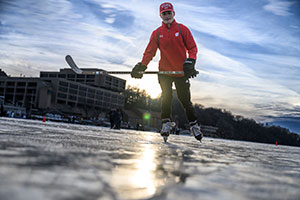Madison is the second largest and fastest-growing city in Wisconsin. Home to the University of Wisconsin and the state capital, it serves as a hub of innovation and advocacy. With a population of around 280,305, Madison offers many big-city amenities yet sits just 20 minutes from the countryside. The city consistently ranks among the best places in the country to live, work, and play. Here’s a sampling of those ratings:
 #5 in 2024 Fittest Cities in America(opens in a new window)
#5 in 2024 Fittest Cities in America(opens in a new window)
American Fitness Index, July 2024- Platinum Level Bicycle Friendly Community
by the League of American Bicyclists, February 2024 - #19 in ParkScore® 2024 for 100 Largest US Cities
Trust for Public Land, 2024 - Top 100 in Best Places to Live in the US in 2024
Livability.com, 2024
 Recreation
Recreation
Paddle, sail, windsurf, swim, fish, or even kitesurf on one of Madison’s four lakes. Or explore the UW Arboretum, a favorite spot for runners, hikers, cyclists, and cross-country skiers. The city also offers countless parks—perfect for enjoying the outdoors or joining residents on one of our seasonal intramural sports teams.
Arts & Culture
Madison boasts a vibrant arts scene. Enjoy world-class theater, dance, and concerts at the Overture Center, a state-of-the-art performing arts complex in the heart of downtown. Residents and visitors alike love the Madison Museum of Contemporary Art and the Chazen Museum of Art. The city also features a lively local music scene, diverse restaurants, and an energetic intellectual and political climate.
Many distinct neighborhoods add to Madison’s unique character. Organizations such as Centro Hispano of Dane County, the Boys and Girls Club of Dane County, Hmong Madison, Ho-Chunk Nation, and Outreach Madison LGBTQ+ Community Center help create a welcoming community. Events like Taste of Madison, Make Music Madison, the Willy Street Fair, and Capital City Salsa Social bring people together throughout the year.
Sports

Wisconsin takes pride in its Badgers. The UW Women’s Hockey team is currently dominating the national scene—having secured their eighth NCAA championship in March 2025. The Men’s Hockey team has secured two NCAA Championships and won the Frozen Four in 2014. The Women’s Volleyball team has made seven consecutive NCAA tournament appearances and ranked second in national attendance among Division I programs during the 2019 season. The Football team has won the Rose Bowl three times and captured 14 Big Ten Championships, while the Men’s Basketball team has claimed multiple Big Ten titles and made 20 straight NCAA Tournament appearances. The Women’s Basketball team also boasts several NCAA and WNIT appearances.
Working in Madison
Wisconsin is an outstanding place to practice family medicine. About two-thirds of our graduates choose to stay in the state for jobs or fellowships, working in settings that range from tribal clinics in northern Wisconsin to Federally Qualified Health Centers serving rural and urban communities. Family physicians here often practice full-spectrum care, including hospital privileges and obstetrics, all within a state with one of the lowest rates of malpractice lawsuits in the country.
Madison itself offers an affordable cost of living, a stable economy, and ample employment opportunities. Major employers include the state government, UW–Madison, American Family Insurance, TruStage, and Epic Systems. Several chambers of commerce—including the Hmong Wisconsin Chamber of Commerce, Latino Chamber of Commerce, Madison Black Chamber of Commerce, and Wisconsin LGBT Chamber of Commerce—support our thriving and diverse business community.
 Links
Links
- City of Madison (The official website for the city)
- Greater Madison Convention & Visitor Bureau
- Isthmus (The resource for what is happening in Madison!)
- Madison Chamber of Commerce
- Wisconsin’s Farm Fresh Atlases
- Travel Wisconsin
- Wisconsin.gov
